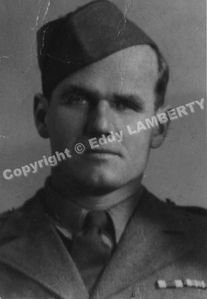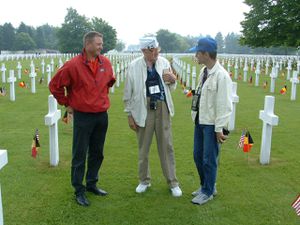Battle of Trois-Ponts, the 80th AAA Bn in action.

December 21, 1944, 
Trois-Ponts, Belgium
by Cpl. Gordon A. WALBERG,
A Btry, 80th A.A.A. Bn,
82nd Airborne Division.
« After 59 days of combat in Holland and the “Market Garden” mission we returned to Suippes, France. On December 7th, 1944, I received a pass to Paris where I spent four days with my friend Chuck MAHALECK. By December 17th, I cautioned my squad to get some sleep and secure warm clothes, sleeping bags and ammo.
December 18, 1944, at 04.00 a.m. Sgt. Fox woke me and said to pull out before dawn. The Germans had broken through the American lines in the Ardennes in Belgium hitting the hardest at the 106th Infantry Division. I secured all supplies I could get stored in my ‘B’ bag. I had a good breakfast at the mess hall and lined up jeep and 57mm into a convoy and started out. Others promised to follow as soon as large trucks could be secured from the Air Force.
We could not await the arrival of the Air Corps trucks to move our 80th AAA Battalion. Paul SCHLUPP, the jeep driver, Morris KARSHENBAUM and I in rear seat departed from Suippes. We had only eight rounds of 57mm shells, our jeep and the 57mm anti-tank gun. No planes flying because of the terrible weather. Our only plans were to advance as far as possible heading for Liège, Bastogne, St. Vith or Trois-Ponts, Belgium. Our only orders were to advance until we made contact with the enemy. We later discovered this would be the advance elements of the 1st SS Panzer Division, one of Hitler’s most feared. On the way, we stopped at the Bastogne crossroads and the MP said we were not needed so we went on to Werbomont. By 09.00 p.m., our convoy had moved more than 170 miles and went into a defensive position near Werbomont, Belgium. We were not a part of a large group and we did arrive before the trucks.
We went further down to the Lienne creek. As we approached the bridge we found it blown. This was where the 291st Engineers stopped the Kampfgruppe PEIPER before his troops were surrounded in the village of La Gleize. We slept under our jeep where we laid down on the ground covered by sleeping bag afraid to get into the bag since the delay in getting out in a hurry.
December 19, 1944, at dawn I awoke and could hardly move. I was so stiff from the long jeep ride and sleeping on the cold ground. The temperature about 10° above zero, cold, fog misting and most uncomfortable. We were right in the middle of the “Battle of the Bulge”. After the coffee and discussion on what way to go, I returned to my sleeping bag rolled it up and carried it to the concealed jeep. Early in the morning, they had put planks down and we crossed the Lienne creek and turned left. We found five to seven knocked out armored vehicles of the advance element of the 1st SS Panzer Division. The dead were still lying near the vehicles and we noted the olive drab or G.I. blankets so we knew this unit had already captured American equipment, fuel and other items needed for their advance. We moved most of the day and stopped at a farm house that evening and took over an aging barn. At least it was warm and we spent the night there.
On the 20th of December, in the evening we were diverted to the road toward Trois-Ponts to prevent any Panzer to cross the Salm River. We set up our gun that evening in the front yard of a farm and Paul SCHLUPP made a deal that if we were allowed to come in and get warm we would share supper rations. The farmer had fought in World War I and went to the basement and got a bottle of French Cognac of 1918. He said he was keeping it for an important occasion and if the Americans chased the Germans out this would be the day. We furnished the cheese, Nescafe and our crackers. We knew that the next day contact would be made. Lieutenant BULLIS, Paul SCHLUPP, Morris KARSHENBAUM and I slept on a bench in the farmhouse with each men staying with the gun two hours each.
A few moments before the attack, I told Morris KARSHENBAUM and Paul SCHLUPP to remove their overshoes and long wool coat and be prepared to move rapidly. I thought the weight of the overshoes and coat would hold us back.
Shortly after we had the guns set up, everything broke loose. Sergeant Richard SCOTT was wounded and Lt. Jake WERTICH was killed by two shots to the head. He was later posthumously awarded the Distinguished Service Cross. The first gun was knocked out after firing at the tanks. It was then that Sgt. SCOTT came back to me and said that shrapnel had cut his clothing and his back. After examination of his back side as best as I could while firing all around us. I told him to go to the aid station located in a small stone building in Trois-Ponts.
Our gun team, SCHLUPP, KARSHENBAUM and myself waited the tank and would
I then left the gun to see what was left of our right flank. To my left was the side of the mountain with the rough approach to the Salm River and the village of Trois-Ponts. As look up to the right, I spotted at least three Germans. The first one aimed his Mauser rifle and fired and I went down with a gun shot wound to the right shoulder. I later learned that the bullet passed the right shoulder following the clavicle going through the right lower lung and out middle of my back. TAYLOR Stokes Cpl. Kia Dec21,1944
I was knocked backward about 12 feet by the impact with my helmet over my eyes. I waited a few seconds and leaped up with my M-1 that was close to me, flicked off the safety, and fired eight rounds at the scattering Germans to frighten the enemy and save myself. I replaced a new clip in my rifle and fired four more times. Then a stoppage in the rifle which didn’t help either. I yelled at Paul SCHLUPP to look to his right and he did and shot the German in the head. I hollered again to look to right of me and he shot the next one in the shoulder knocking the Kraut down.
I shouted to my men I needed to go to the aid station. As I started the long way down the hill, the Germans began to shoot along the road, and was kicking up parts of it. By this time, Paul SCHLUPP took over the gun allowing me to go down the side of the mountain. This is the reason I chose to go down the side of the mountain and not the road. My itinerary to the aid station was carrying my gun, running, falling, crawling the entire route down the cliff to the railroad track, embankment. I finally found a shale lined and shallow place and waded across the Salm River.
As I crossed over toward the houses and approached the aid station, I saw an American officer who asked if I were deserting my position. I was a little fed up but I pulled my jacket down and showed him my wound. He directed me to the battalion aid station, the 307th Medical Co. As I walked away, I suggested he would do more good up on the hill and not here in town.
I finally arrived at the aid station with an overhang on side of La Salm. The doctor, Captain Robert FRANCO, made leave my M-1 behind the large front door where I entered. He examined me after removing my sweater which was in shreds of unravel and cutting off my long underwear top. He told me to take 16 sulfa pills and a shot of penicillin which was a new drug being used to reduce the amount of bacteria in the wound. A blanket was spread on the dirty floor and I laid down.
At this time, a noncom came in and said it looked like the Germans were going to enter the village and he asked what he should do. The doctor notified that he couldn’t leave the wounded and added that any who wanted to escape should do so. This we did with 12 on the jeep. With the temperatures well below the freezing mark, I chose the front of the hood because it was warmer there and I only had a blanket over my shoulder. I wanted to take my rifle but was told to leave it inside the door of the aid station and I secured a red cross flag instead. Despite this sign, we were still fired on as we pulled out from between the buildings. We located the ambulance parked about 4 miles to the edge of town.
This day of December 21st, 1944 showed courage, depression and sadness among the death and wounded of many along with confusion but later on it will also show that the German thrust was stopped and they did not enter Trois-Ponts.
The ambulance took us toward Huy, Belgium and we were directed to a little schoolhouse where operations were being made in one of the classrooms with portable lights overhead. En route to the school, rear guard troops stopped the ambulance and asked us who Betty Grable was and what kind of a team Brooklyn Dodgers was and other such questions. Since Germans dressed in American uniforms had been captured working behind our lines, I assured them we were all Americans with wounds and shouldn’t delay us.
Again, not a normal day in the life of a 22 years old soldier. At the schoolhouse, a nurse who couldn’t believe how we got so dirty, washed my arm and my back gently because of my wounds. A couple hours later around 02.00 a.m. on December 22, 1944 they operated on me. Around 11.00 a.m. we were told to get any thing that we wanted to take along and got in an ambulance and we went to Liege. This due to an increase bulge in the Americans lines and the fear if a complete breakthrough was completed the hospital and wounded be captured.
Someday, I wish I could locate the small schoolhouse where the field hospital team operated on me. I would believe it would be in the Huy/Liege area but our ambulance did take so many detours to avoid the Germans troops pushing in the Bulge area.
Gordon A. WALBERG, Illinois, USA
Copyright © 2003-2011 Gordon A. WALBERG & Eddy LAMBERTY
![]()

KIA above Trois-Ponts on Dec 21, 1944
 Gordon WALBERG back in 1997 above Trois-Ponts.
Gordon WALBERG back in 1997 above Trois-Ponts.

Cemetery Henri-Chapelle Static Line Tour 2004
L-R: Eric Michel, Gordon Walberg, Eddy Lamberty.
![]()
Please send your comments, WWII accounts or anecdotes, WWII pictures to:
Eddy LAMBERTY
Avenue Joseph Lejeune 45
4980 Trois-Ponts
Belgium
Or:
| | eddy.lamberty@gmail.com |
